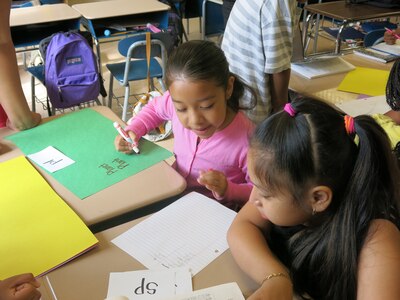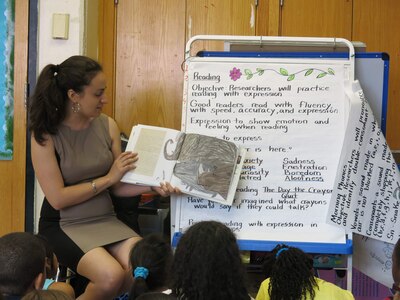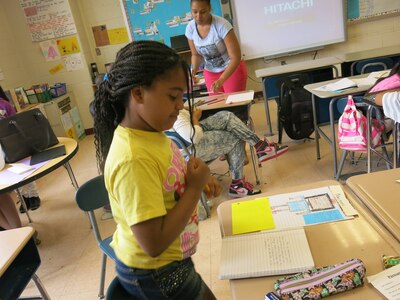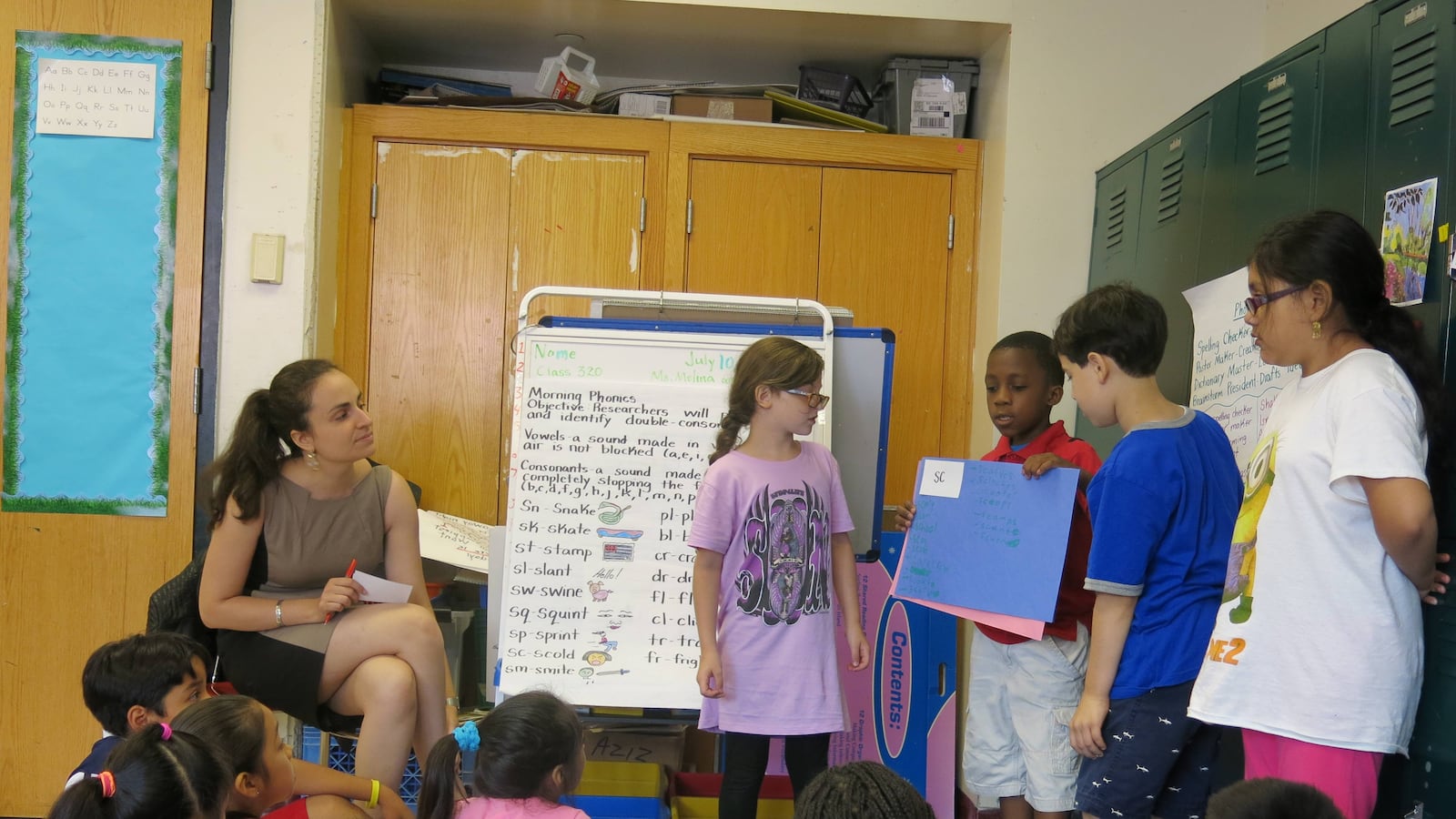Class doesn’t officially start for another five minutes, but by 8:40 on Thursday morning, Natalie Molina is collecting homework from her students and describing the subjects they’ll cover over the next few hours: phonics, reading, writing, and math.
It’s an ambitious plan for the peak of summer vacation, but Molina’s students don’t complain; instead, they grab their notebooks and follow Molina to the classroom easel as they start their fourth day of Summer Quest.
A free, five-week program combining academic instruction and camp activities, Summer Quest serves 2,800 low-income elementary and middle school students—some of whom are participating as an alternative to summer school—at sites throughout Brooklyn and the South Bronx. Chancellor Carmen Fariña has highlighted the program as a way to stem summer learning loss, and the results from this third and final summer of its pilot program will help determine whether that claim is true.
Like students at all Summer Quest sites, Molina’s rising fourth graders spend half their day on reading, writing, and math and the other half rotating between activities like martial arts, hip-hop dance, and music. To get a better sense of the academic component of the program, Chalkbeat visited Molina’s class at a Summer Quest site in the Bronx run by the nonprofit BELL and the Rafael Hernandez Dual Language Magnet School. Below is our “anatomy of a lesson.”
8:41 a.m. Molina sits next to the easel in the corner of the classroom, and her students (she calls them “researchers”) gather around her. The easel paper displays the phonics objective for the day: “Researchers will pronounce and identify double-consonant blends.”
The lesson is from a second-grade book, Molina later explains, because her students’ literacy levels range from kindergarten to fifth grade. She says some students will be switched into different age groups the next week to better fit their needs. Nineteen of the 20 students in Molina’s class are English language learners, and most speak Spanish or French at home.
“What happens in your throat when you say a vowel?” Molina asks, instructing the students to put their hands on their throats and together say “A E I O U.” Vowels make your throat vibrate “like an opera singer,” she says. A consonant, on the other hand, stops at your lips.

The students then read a list of double-consonant blends written on the easel. Molina pauses at harder words such as “cram” and “plush” to provide examples, often from her own life. The stories range from pranks she pulled on her brother as a kid, which leave the students giggling, to Molina’s experiences in college. Sleeping in the science center at Wellesley the night before a final exam, she says, was one way to “cram.”
Molina divides the students into groups and assigns each student a role: spelling checker, poster maker, dictionary master, or brainstorm president. The groups receive a few double-consonant blends. Their task is to compile a list of words that start with each of these blends and write them on oversized pieces of construction paper.
“The more words that you write, the more scholar dollars that you earn,” Molina promises, to the visible excitement of the students. Eventually they can use these dollars—which are gained by “completing tasks to the best of your ability and on time,” according to Molina—to “purchase” small prizes.
The students get to work searching through the dictionary. Some words come easily to them, but students also copy down others—like “spectroscope” and “Sphinx”—that are unfamiliar. Later, one girl wonders if “spoonbill” means “a special kind of spoon.”
The activity ends with the groups presenting their work to the rest of the class. When the students read off a difficult word, Molina writes it down to add it to the class vocabulary tree.
“They really struggle with double- and triple-consonant blends, especially because they don’t exist so much in their native languages. Students are really unaware of where in the mouth the sound is made. Next time, I may have them define the words that are trickier from the dictionary so that they can share out with the class what it means.”
10:04 a.m. Students have been practicing phonics and vocabulary for over an hour, and Molina decides it’s time for a break. She announces a “music minute,” and the students jump up and dance to “Jai Ho” from “Slumdog Millionaire” and Shakira’s “Waka Waka.”
“It really gets them moving, gets the oxygen flowing. I really felt the energy decrease. It is something that I did last year and it was really successful.”
10:15 a.m. It’s time to settle down and move on to reading.
This past school year, Molina switched from teaching second to third grade, and saw firsthand how her students’ reading skills had suffered over the summer. Summer Quest, she believes, can help address that learning loss by creating “a continuity between the previous year and the year that comes in.”

Before beginning the book “The Day the Crayons Quit” by Drew Daywalt, Molina points to a phrase written on the easel: “The teacher is here.” Together, the students proclaim “The teacher is here” over and over, each time using a different emotion written on the easel paper, including fear, happiness, anxiety, boredom, and curiosity. The exercise introduces the lesson’s goal, to practice reading with expression.
“Everybody, kiss your brain!” Molina says when they’re done. It’s a phrase she repeats often throughout the morning. The students congratulate themselves on their academic focus by kissing their hand and then tapping their head.
Molina begins to read “The Day the Crayons Quit.” In the story, a boy named Duncan finds a stack of letters written to him by his crayons. The colors have some bones to pick with their owner—red is tired of being overworked around Christmas and Valentine’s Day, and orange and yellow debate who should be used to draw the sun. Ultimately, Duncan must reimagine all the colors’ traditional roles to make his crayons happy again.
Halfway through the story, Molina stops reading and puts the students into groups of two or three. Each team receives a copy of a different page from the second half of the book, and they practice for a few minutes before reading their page, with as much emotion as they can muster, to the rest of the class.
“I love that book. I have used that book to teach letter writing. I decided today to use it to teach expression because I noticed that so many of them were reading in monotone. The goal of that lesson was really to get them to change their tone, the expression on their face, to really start to internalize what it means to say things with that writer’s intention.”
11:02 a.m. With only an hour to go before lunchtime, the class still needs to cover writing and math. Reflecting the Common Core’s emphasis on interdisciplinary learning, today’s lesson ties them together.

The day before, the students created robots on graph paper to calculate their area and perimeter. Today, the writing objective is to “persuade children their age to purchase a special robot.”
“With the same emotion and expression we learned about in reading, we are going to write a persuasive paragraph,” Molina says.
Molina reads a sample paragraph, which encourages students to purchase Homero the Homework Robot. “How many people would like to buy this robot?” Molina asks afterward.
Hands shoot up. “Is it real?” one student wants to know.
Next Molina distributes a handout with persuasive phrases, and the students begin writing. Ashley Perez Peña’s paragraph starts with a question: “Are you tired of your mom always waking you up for school?” If so, her robot can help—its job is to take a student’s place in class.
“A lot of students’ issues with writing stem from the fact they don’t know the language necessary for the different kinds of writing. Going into fourth grade, students must be able to do persuasive writing at a much higher level.”
11:37 a.m. It’s time for a short math review. Molina asks the students to find the perimeter of a rectangle that she doesn’t draw—rather, she only states its length and width so the students must visualize and solve the problem in their heads.
The students are given time to finish their calculations and work on their persuasive paragraphs. Soon the robots will be ready for the bulletin board.
“The pace of Summer Quest is very different and so is the attitude. During the school year, we’re really pressed for time with the students. During the summer, we can take time to teach the skills students need.”
Three hours after handing in their homework, the group is still in good spirits, if a little restless for lunch. According to one student, the academic component of the day is both important and helpful.
“It refreshes your memory,” Genesis Vasquez says. “It gets you prepared for fourth grade.”
Want the latest in New York City education news? Subscribe to our Rise & Shine newsletter.


